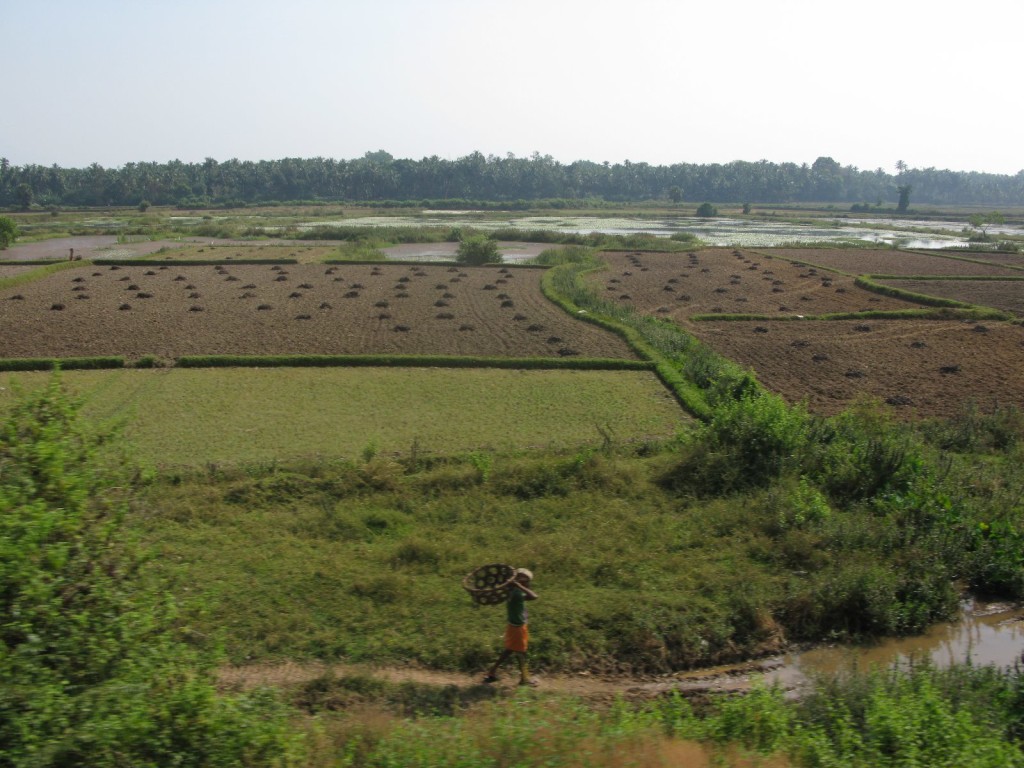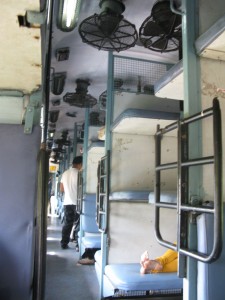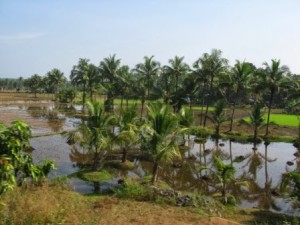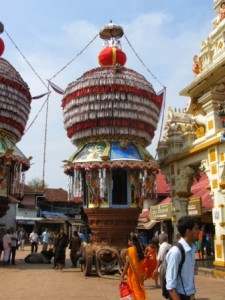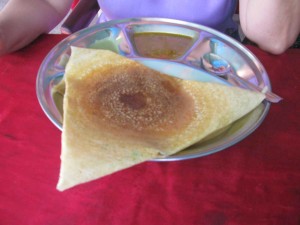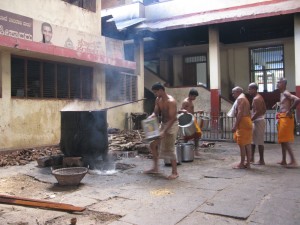We said goodbye to Patnem early on Friday morning as we took a taxi to Margao at 5:30 to catch our 7:10 train. We could have had longer lie in since the journey only took 45 mins at that early hour, but better safe than late. Luckily the train was only running 15 mins behind schedule.
The scenery was lovely as we travelled down the coast – flooded paddy fields being planted with a second rice crop, wide rivers with fringes of mangroves, and the Ghats rising sharply in the distance. On more than one occasion fishermen in boats waved to the train. Most railway building projects encounter opposition from those who live along the proposed route, but the Konkan railway was seen as so important for the economic development of this part of the coast that people willingly relinquished ancestral land to enable construction of the line. The express train on which we were travelling stopped infrequently, but when combined with the slower local trains must make a big difference to the lives of those living along the narrow coastal strip, with much faster access to markets and healthcare. I can’t imagine that the guy who daily hawked strawberries from Mahabaleshwar (a hill station just south of Mumbai) to the beach restaurants in Patnem and Palolem would be in business if he had to rely on trucks or buses – his fruit would be mush long before it arrived.
Now that we’ve left Mumbai and Goa behind, we get more bang for our buck, hotel-wise. Our large, smart room at the Shambhavi in Udupi wouldn’t be out of place in the UK apart from a couple of things (such as the bucket and jug in the bathroom and cool tiled floor rather than carpet) and is costing £8.80 a night. The major downside is that the room faces south, so gets very hot – but we don’t want to shell out an additional £9 per night for an air con room. The price of food has plummeted too, although beer is a little more.
Udupi is a pilgrimage town as it contains a large Krishna temple and several monasteries. Traffic is excluded from the streets around the temple, so it’s wonderfully peaceful. Two large, bulbous, domed chariots stand outside the main temple, into which flows a steady stream of devotees. Inside the dark, cool building they queue patiently to shuffle past a small grill, behind which stands an image which they believe contains the essence of god. Hinduism is often thought of as having many gods, and to involve the worship of idols, but it’s more subtle and complex than that. Fundamentally there is one god who has many aspects, and who may choose to inhabit certain images – it is not the image that is worshipped, but the spirit of god within it. Beyond the main image is a raised area where people were praying, kneeling and touching their forehead to the ground, receiving blessings of coconut oil(?) from monks, or simply sitting quietly. Apart from a low murmuring of prayer and the shuffling of feet, the only noise was the ringing of bells by worshippers – we sat for perhaps half an hour, just absorbing the atmosphere.
Udupi’s other claim to fame is as the birthplace of the dosa, that thin, crispy pancake of rice and lentil flour that forms most of our Sunday lunches back home. Wrapped around a dollop of spicy mashed potato and served with yoghurt-coconut chutney and soupy lentil sambar, it’s hard to think of a finer breakfast or lunch. We’ve had several, needless to say.
I like it here, although there’s not much to see apart from the temple. One reason is that we are pretty much ignored. They have seen enough tourists that we are not objects of curiosity, except to the occasional school child, but not so many that we are seen as any more of a earnings opportunity than the local populace – so nobody tries to persuade us into their shop or their rickshaw, and the few beggars don’t single us out. The only time we’ve really felt our tourist status was outside the temple, where a young woman with a highly decorated cow tried to sell us a photo opportunity – but presumably Indians with cameras are also approached, since there are not enough foreigners here to make the enterprise worthwhile.
We’ll be moving on to Kannur tomorrow, about 3.5 hours down the coast. We had planned to go inland to Coorg, an upland coffee growing area that is likened to Scotland or Switzerland (although neither of those places is famous for coffee, as far as I’m aware!), but it means going to Mangalore then either a 4 hour bus ride or about £30 for a taxi (and the same out again) plus accommodation on plantations, one of the main reasons to go, is quite expensive. So we’ll just tootle down the coast instead.
We went to get some cash in preparation, as we will be staying outside Kannur, and a most bizarre thing happened. A rickshaw with flags and loudspeakers stopped in the main square, almost in front of the bank, blaring whatever message it was, then a volley of deafening firecrackers were let off in the middle of the street, creating a pall of smoke and bringing traffic to a halt (try doing that in the UK without getting arrested!). A long cavalcade of rickshaws, all with yellow, red and green striped flags, then proceeded to drive by – there must have been a couple of hundred of them, all in single file. We asked our neighbour in the ATM queue what was going on, and the most surprising thing about the whole episode was – he hadn’t actually noticed anything. Evidently in Udupi you need more than loudspeakers, flags, firecrackers and 200 tuk-tuks (with police escort) if you want to get people’s attention!


